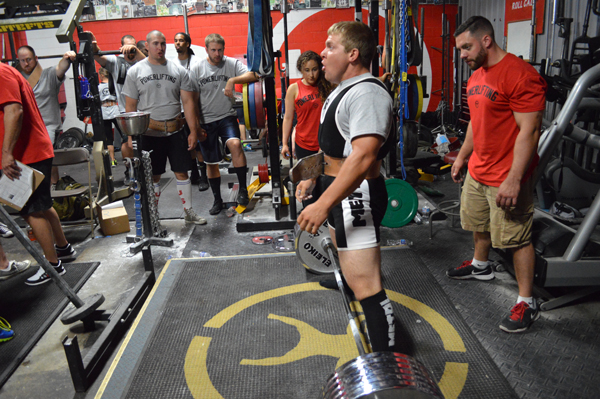
I hate deadlifting. I could go the rest of my life without doing another pull and I would be fine with that. Since my first competition back in 1983, my deadlift has been a struggle. It was nothing like my squat and bench press which were my strong lifts. I’ve tried everything to fix it- from deadlifting three times per week, to twice per week, to once a week, to once a month, and (my favorite) not deadlifting at all. However, I never gave up and eventually I was able to build my pull to a point where it became my “means to a total,” and I still look for new ways to build bigger deadlifts today. The difference is now I really don’t care about my own deadlift but I do care about how I can help others pull more.
The deadlift is surprisingly complex. While it’s cool to say “just walk up to the fucking bar and lift” that’s not enough. I laugh every time I hear that. If only it was that simple. It certainly won’t cut it if you’re stuck at a plateau—and a deadlifting plateau can be the worst you’ll ever come across.
Like the bench press and squat, a deadlift plateau is due to one of three issues:
Physical – programming, mobility, strengthening weaker muscles and movements.
Mental – level of arousal or over-arousal.
Technical – exercise technique and execution.
Most lifters think their deadlift slump is due to physical issues. So they ask, “What exercises should I do?” or “How do I tweak my programming? Do I pull every four days or every five?” They have it all wrong. In my experience, only 20% of deadlifting slumps are due to physical issues or programming flaws. Technical or technique problems represent a full 70% of lifters’ challenges, with mental issues making up the final 10%.
The deadlift now rules Instagram and keeps gaining in popularity. As a result, you now hear guys spouting that the deadlift is the “true” measure of strength. Ten years ago, the argument was the squat or the bench press was the true measure of strength, as too many otherwise weak people can sport above average deadlifts just by having the right leverages. Here’s the thing:
Whatever a lifter is strongest at will always influence the “best strength indicator” debate.
So every 600-pound raw bencher is going to say that the bench press is the true measure of strength, just as every 1000-pound squatter will say the same thing about the squat.
The fact is, it's what you’re shitty at that really measures ability.
The keys of proper deadlift setup are things I learned as a young lifter from Bob Wahl, Louie, Ricky Crane, Steve Goggins, and Ed Coan. Honestly, I can’t remember who I learned which aspect from, so I want to make sure they all get credit. That’s a pretty esteemed list of teachers, and for a reason—my deadlift sucked so I consulted the best.
Foot position is much ado about nothing. Here’s how you figure out your ideal width: Hang from a chin-up bar and drop to the floor. Note your foot position when you land. That’s the right conventional deadlifting stance for you. I think I first learned this from Fred Hatfield but have used it many times over the years with lifters as well as with run-of-the-mill personal training clients.
This can vary from right against the bar to six inches or more away from it. I think mid-foot distance is an optimal starting point but it really depends on quad size. Someone with huge quads will need the bar further away so it doesn’t ride up and hit the quads—meaning if you have John Meadows-like quads the bar will be stuck under them and you’ll have to pull over and around them- while someone with skinny quads and no teardrop can start much closer. Again, mid-foot is a great starting place. Some lifters like to lift the toes to get the weight moving backwards while others find twisting the feet (meaning the action of doing this, your actual foot doesn’t move) helps activate the glutes. I like the most natural position to start. This lets me keep an “ace in the hole” so if I find it sticking mid-lift, I can turn my toes (twist). This will further contract my glutes, which may be enough to keep the weight moving. If I did this from the start, the glutes would already be firing all-out at the sticking point and as such, couldn’t be “called in” to assist.
I prefer a slight, not extreme, arch in the lower back. The upper back should be rounded and somewhat relaxed, the shoulders slightly slumped. This improves leverage and shortens the distance of the pull. At no point during the pull should you allow the spine to enter into hyper flexion.
To set up, I normally coach guys to just drop the arms straight down and grab the bar (although a bigger, heavier guy with broad shoulders will need to be a bit wider). Keep the arms straight but relaxed. There’s no need to flex the triceps unless in extreme situations. If the hand position is correct then the hips should be where they need to be. We don’t want the hips to be in the squat position (too low) or in a Romanian deadlift position (too high). The best descriptor would be like a quarter squat. This allows for the ideal hinge and posterior chain recruitment. Also, there’s knurling on the bar for a reason so if you need to grip one finger wider to use it then do so. The biggest mistakes I see with grip are holding the bar way too close on a sumo deadlift and too wide with a conventional. Of course there will always be deviations from the norm, but if you shoot for keeping the arms in a straight line you’ll probably end up in a good position.
Note: If you’re a powerlifter, I suggest using a mixed grip as this is how you’ll compete. If you aren’t a competitive lifter I “normally” suggest not using a mixed grip (and if you need straps then use them) but this depends on what you’re training for and what the deadlift has been put into the program to enhance.
The idea is to drive the head back into the traps, not just look up. The excessive head cranked up towards the ceiling thing you see today is completely unnecessary. It’s also counterproductive. The head follows the body, so you want to drive the head back, not up. For the same reason, looking down is a surefire way to miss a lift. Find a spot on the wall that requires you to keep your head up and back into the traps and begin the pull from there. Another head position issue I find (working with powerlifters) is their traps and upper backs get so thick that they have a hard time keeping their heads up in the first place. I’ve seen guys so thick they can barely turn their heads to the side without having to rotate their torso. Telling them to look up will get you about as far as asking them to pick up a nickel they dropped on the floor. You can scream at them all day to get their heads up but if the structure won’t allow it they’ll just tune you out. However, they can and should drive their heads back into their traps and this is what you need to look for.
The first thing to do after the setup is to pull the slack out of the bar. Reach down and grab a loaded barbell. Hear that clicking sound? That’s the sleeve of the barbell connecting with the collars. You want to remove that play before you initiate your pull. That’s what guys mean when they say to pull the slack out of the bar. Doing this initial “pre-pull” allows the hips to drop down slightly. Although this step is subtle, if skipped, the hips will slide out of position once you really start to pull, which is when the weights break from the floor.
Wear your belt as tight as you can. I always cinch mine at least 1 or 2 holes tighter than where I have it when I squat or bench. It’s so tight I basically can’t breathe, meaning I can only draw in about 50% of the air I can normally draw in.
Less air in the lungs helps keep everything—the lungs, the chest—lower, making it easier to hit the lockout position. If you don’t wear a belt, just remember to draw in 50% of your lung capacity, brace your torso, and keep everything tight.
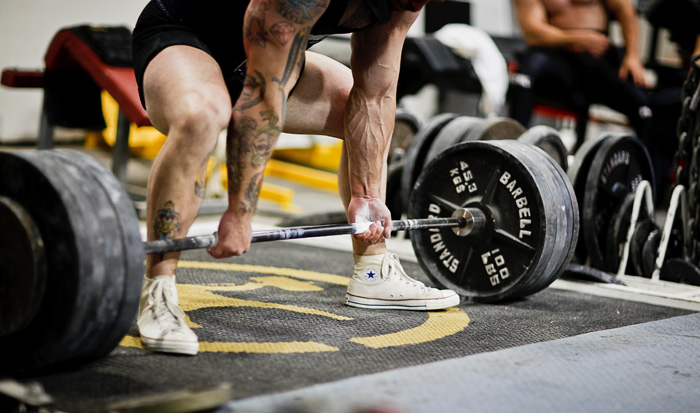
Sumo is obviously a wider setup, with the hips closer to the bar. From the side, a good sumo deadlift should look almost like a leg press in that the torso doesn’t move much. The rules for pulling sumo really aren’t much different from what’s been presented above except for how you get into the start position. Your stance will be based (again) off what you “feel” works best. Sumo can go from modified to ultra wide—whatever allows for the best pulling position and bar path is the one to use. Once this is determined, you want to drive your feet apart (spreading the floor) while trying to keep your knees in line with the ankles. This keeps the hips closer to the bar. When I teach the sumo pull I tell people to get their starting position so their crotch is over the bar i.e., “balls over bar.” For some, the easiest way to do this is to start in a standing position and squat down. Others find it easier to bend over, get the grip, and then pull the chest up to bring the hips forward. Go with what works best, but I will say that from teaching hundreds if not thousands of lifters it’s easier to teach them to get the position by squatting down. Even if they change later they’ll get the idea of what the start should feel like.
Let’s not forget all the cues. Each point that I covered could be communicated in various ways. Coaches use different cues to accomplish basically the same thing: “Keep the shoulders in line with the bar” versus “Chest up” for example. However, depending on the lifter, one may be too much information and the other not enough. This is true with all lifts and all sport skills for that matter. So if you have doubt, ask what the end result should be, or look for it in the cuing being used. Don’t let a confusing cue knock you out of your most natural lifting pattern.
Key point
A key point that often gets overlooked is that a deadlift, be it sumo or conventional, is less about pulling up and more about pulling back. You know you’re setting up right when the only thing preventing you from falling backward on your ass is the weight of the barbell. To understand why, think of the deadlift as a teeter-totter. Say you weigh 250 pounds—you want to get as much of your bodyweight helping you pull that weight as possible. This means less pulling up and more falling back. So, if you had 250 pounds on the barbell, your bodyweight alone should be enough to move the weight—without you exerting an ounce of force. You’ll know you’re doing this correctly when your warm-up sets seem to fly up from the floor like you were using a broomstick instead of a loaded barbell.
You don’t have to like every exercise you perform. And you won’t get any grief from me if you say you hate the deadlift. However, like it or not, you need to respect it. And if something is so important that you force yourself to do it despite hating it with every fiber of your being, then you might as well do it right.









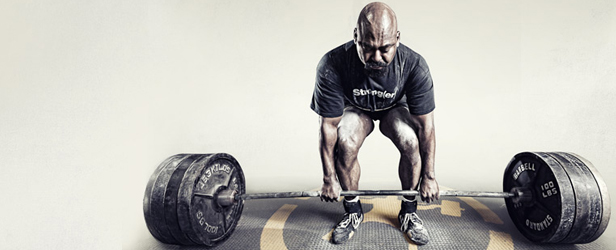
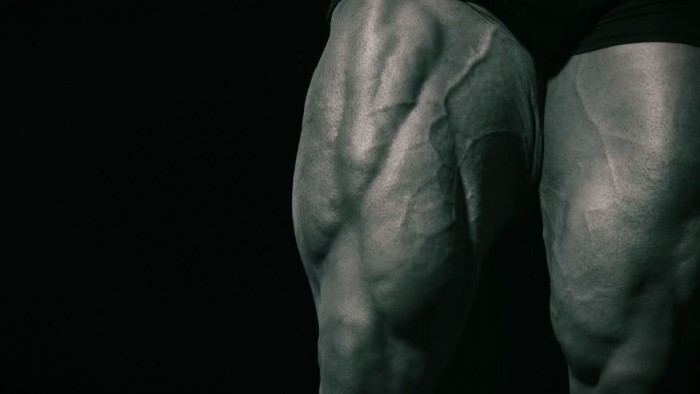
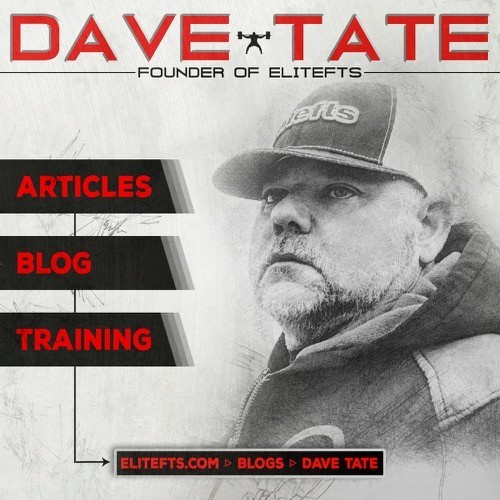
And I still say it is the measure of strength to judge all others
By. You use almost every muscle maximally in your body to lift.
End of story.